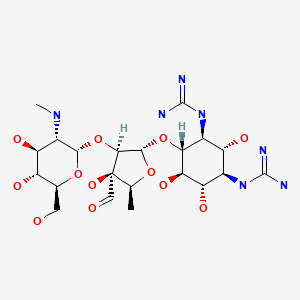Attribution Statement: LactMed is a registered trademark of the U.S. Department of Health and Human Services.
NCBI Bookshelf. A service of the National Library of Medicine, National Institutes of Health.
Drugs and Lactation Database (LactMed®) [Internet]. Bethesda (MD): National Institute of Child Health and Human Development; 2006-.
CASRN: 57-92-1

Drug Levels and Effects
Summary of Use during Lactation
Similar to other aminoglycoside antibiotics, streptomycin is poorly excreted into breastmilk. Newborn infants apparently absorb small amounts of aminoglycosides, but serum levels are far below those attained when treating newborn infections and systemic effects of streptomycin are unlikely. Older infants would be expected to absorb even less streptomycin Monitor the infant for possible effects on the gastrointestinal flora, such as diarrhea, candidiasis (e.g., thrush, diaper rash) or rarely, blood in the stool indicating possible antibiotic-associated colitis.
Drug Levels
Maternal Levels. Forty-six mothers receiving intramuscular streptomycin 250,000 MU had milk streptomycin levels measured hourly after a dose. The peak concentration in milk averaged 0.64 MU and occurred 9 hours after the dose. Mothers with unilateral mastitis had higher levels in the breast with mastitis than in the unaffected breast.[1] Although it is not clear what the above dose was in milligrams in this older Russian paper, if the same proportion is used, a 1 g intramuscular dose would result in a peak streptomycin milk level of 2.6 mg/L.
Infant Levels. Relevant published information was not found as of the revision date.
Effects in Breastfed Infants
Relevant published information was not found as of the revision date.
Effects on Lactation and Breastmilk
One observational study found no inhibition of lactation by streptomycin.[1]
References
- 1.
- Rudneva NN. Akush Ginekol (Mosk). 1967;43:48–52. [Effect of penicillin and streptomycin on lactation in parturients] [PubMed: 5629407]
Substance Identification
Substance Name
Streptomycin
CAS Registry Number
57-92-1
Drug Class
Breast Feeding
Anti-Infective Agents
Antibacterial Agents
Aminoglycosides
Antitubercular Agents
Disclaimer: Information presented in this database is not meant as a substitute for professional judgment. You should consult your healthcare provider for breastfeeding advice related to your particular situation. The U.S. government does not warrant or assume any liability or responsibility for the accuracy or completeness of the information on this Site.
- User and Medical Advice Disclaimer
- Drugs and Lactation Database (LactMed) - Record Format
- LactMed - Database Creation and Peer Review Process
- Fact Sheet. Drugs and Lactation Database (LactMed)
- Drugs and Lactation Database (LactMed) - Glossary
- LactMed Selected References
- Drugs and Lactation Database (LactMed) - About Dietary Supplements
- Breastfeeding Links
- PubChem SubstanceRelated PubChem Substances
- PubMedLinks to PubMed
- Review Kanamycin.[Drugs and Lactation Database (...]Review Kanamycin.. Drugs and Lactation Database (LactMed®). 2006
- Review Amikacin.[Drugs and Lactation Database (...]Review Amikacin.. Drugs and Lactation Database (LactMed®). 2006
- Review Tobramycin.[Drugs and Lactation Database (...]Review Tobramycin.. Drugs and Lactation Database (LactMed®). 2006
- Review Neomycin.[Drugs and Lactation Database (...]Review Neomycin.. Drugs and Lactation Database (LactMed®). 2006
- Review Gentamicin.[Drugs and Lactation Database (...]Review Gentamicin.. Drugs and Lactation Database (LactMed®). 2006
- Streptomycin - Drugs and Lactation Database (LactMed®)Streptomycin - Drugs and Lactation Database (LactMed®)
Your browsing activity is empty.
Activity recording is turned off.
See more...
